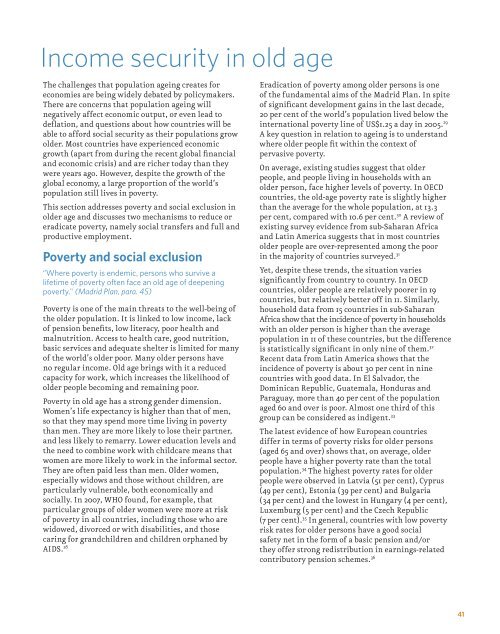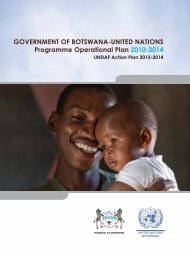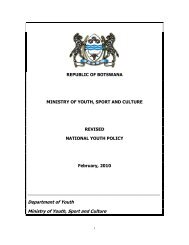Ageing in the Twenty-First Century: - HelpAge International
Ageing in the Twenty-First Century: - HelpAge International
Ageing in the Twenty-First Century: - HelpAge International
Create successful ePaper yourself
Turn your PDF publications into a flip-book with our unique Google optimized e-Paper software.
Income security <strong>in</strong> old age<br />
The challenges that population age<strong>in</strong>g creates for<br />
economies are be<strong>in</strong>g widely debated by policymakers.<br />
There are concerns that population age<strong>in</strong>g will<br />
negatively affect economic output, or even lead to<br />
deflation, and questions about how countries will be<br />
able to afford social security as <strong>the</strong>ir populations grow<br />
older. Most countries have experienced economic<br />
growth (apart from dur<strong>in</strong>g <strong>the</strong> recent global f<strong>in</strong>ancial<br />
and economic crisis) and are richer today than <strong>the</strong>y<br />
were years ago. However, despite <strong>the</strong> growth of <strong>the</strong><br />
global economy, a large proportion of <strong>the</strong> world’s<br />
population still lives <strong>in</strong> poverty.<br />
This section addresses poverty and social exclusion <strong>in</strong><br />
older age and discusses two mechanisms to reduce or<br />
eradicate poverty, namely social transfers and full and<br />
productive employment.<br />
Poverty and social exclusion<br />
“Where poverty is endemic, persons who survive a<br />
lifetime of poverty often face an old age of deepen<strong>in</strong>g<br />
poverty.” (Madrid Plan, para. 45)<br />
Poverty is one of <strong>the</strong> ma<strong>in</strong> threats to <strong>the</strong> well-be<strong>in</strong>g of<br />
<strong>the</strong> older population. It is l<strong>in</strong>ked to low <strong>in</strong>come, lack<br />
of pension benefits, low literacy, poor health and<br />
malnutrition. Access to health care, good nutrition,<br />
basic services and adequate shelter is limited for many<br />
of <strong>the</strong> world’s older poor. Many older persons have<br />
no regular <strong>in</strong>come. Old age br<strong>in</strong>gs with it a reduced<br />
capacity for work, which <strong>in</strong>creases <strong>the</strong> likelihood of<br />
older people becom<strong>in</strong>g and rema<strong>in</strong><strong>in</strong>g poor.<br />
Poverty <strong>in</strong> old age has a strong gender dimension.<br />
Women’s life expectancy is higher than that of men,<br />
so that <strong>the</strong>y may spend more time liv<strong>in</strong>g <strong>in</strong> poverty<br />
than men. They are more likely to lose <strong>the</strong>ir partner,<br />
and less likely to remarry. Lower education levels and<br />
<strong>the</strong> need to comb<strong>in</strong>e work with childcare means that<br />
women are more likely to work <strong>in</strong> <strong>the</strong> <strong>in</strong>formal sector.<br />
They are often paid less than men. Older women,<br />
especially widows and those without children, are<br />
particularly vulnerable, both economically and<br />
socially. In 2007, WHO found, for example, that<br />
particular groups of older women were more at risk<br />
of poverty <strong>in</strong> all countries, <strong>in</strong>clud<strong>in</strong>g those who are<br />
widowed, divorced or with disabilities, and those<br />
car<strong>in</strong>g for grandchildren and children orphaned by<br />
AIDS. 28<br />
Eradication of poverty among older persons is one<br />
of <strong>the</strong> fundamental aims of <strong>the</strong> Madrid Plan. In spite<br />
of significant development ga<strong>in</strong>s <strong>in</strong> <strong>the</strong> last decade,<br />
20 per cent of <strong>the</strong> world’s population lived below <strong>the</strong><br />
<strong>in</strong>ternational poverty l<strong>in</strong>e of US$1.25 a day <strong>in</strong> 2005. 29<br />
A key question <strong>in</strong> relation to age<strong>in</strong>g is to understand<br />
where older people fit with<strong>in</strong> <strong>the</strong> context of<br />
pervasive poverty.<br />
On average, exist<strong>in</strong>g studies suggest that older<br />
people, and people liv<strong>in</strong>g <strong>in</strong> households with an<br />
older person, face higher levels of poverty. In OECD<br />
countries, <strong>the</strong> old-age poverty rate is slightly higher<br />
than <strong>the</strong> average for <strong>the</strong> whole population, at 13.3<br />
per cent, compared with 10.6 per cent. 30 A review of<br />
exist<strong>in</strong>g survey evidence from sub-Saharan Africa<br />
and Lat<strong>in</strong> America suggests that <strong>in</strong> most countries<br />
older people are over-represented among <strong>the</strong> poor<br />
<strong>in</strong> <strong>the</strong> majority of countries surveyed. 31<br />
Yet, despite <strong>the</strong>se trends, <strong>the</strong> situation varies<br />
significantly from country to country. In OECD<br />
countries, older people are relatively poorer <strong>in</strong> 19<br />
countries, but relatively better off <strong>in</strong> 11. Similarly,<br />
household data from 15 countries <strong>in</strong> sub-Saharan<br />
Africa show that <strong>the</strong> <strong>in</strong>cidence of poverty <strong>in</strong> households<br />
with an older person is higher than <strong>the</strong> average<br />
population <strong>in</strong> 11 of <strong>the</strong>se countries, but <strong>the</strong> difference<br />
is statistically significant <strong>in</strong> only n<strong>in</strong>e of <strong>the</strong>m. 32<br />
Recent data from Lat<strong>in</strong> America shows that <strong>the</strong><br />
<strong>in</strong>cidence of poverty is about 30 per cent <strong>in</strong> n<strong>in</strong>e<br />
countries with good data. In El Salvador, <strong>the</strong><br />
Dom<strong>in</strong>ican Republic, Guatemala, Honduras and<br />
Paraguay, more than 40 per cent of <strong>the</strong> population<br />
aged 60 and over is poor. Almost one third of this<br />
group can be considered as <strong>in</strong>digent. 33<br />
The latest evidence of how European countries<br />
differ <strong>in</strong> terms of poverty risks for older persons<br />
(aged 65 and over) shows that, on average, older<br />
people have a higher poverty rate than <strong>the</strong> total<br />
population. 34 The highest poverty rates for older<br />
people were observed <strong>in</strong> Latvia (51 per cent), Cyprus<br />
(49 per cent), Estonia (39 per cent) and Bulgaria<br />
(34 per cent) and <strong>the</strong> lowest <strong>in</strong> Hungary (4 per cent),<br />
Luxemburg (5 per cent) and <strong>the</strong> Czech Republic<br />
(7 per cent). 35 In general, countries with low poverty<br />
risk rates for older persons have a good social<br />
safety net <strong>in</strong> <strong>the</strong> form of a basic pension and/or<br />
<strong>the</strong>y offer strong redistribution <strong>in</strong> earn<strong>in</strong>gs-related<br />
contributory pension schemes. 36<br />
41







